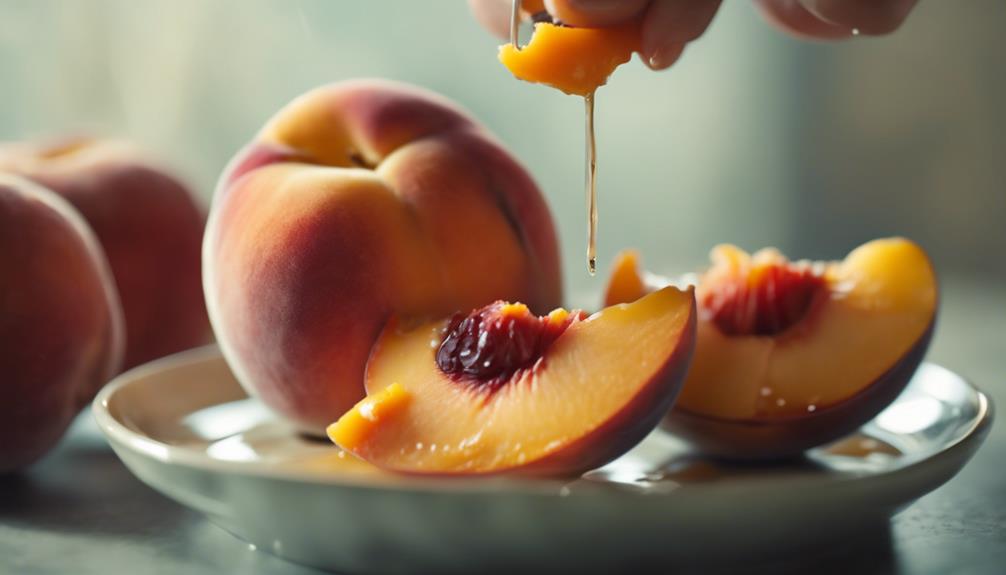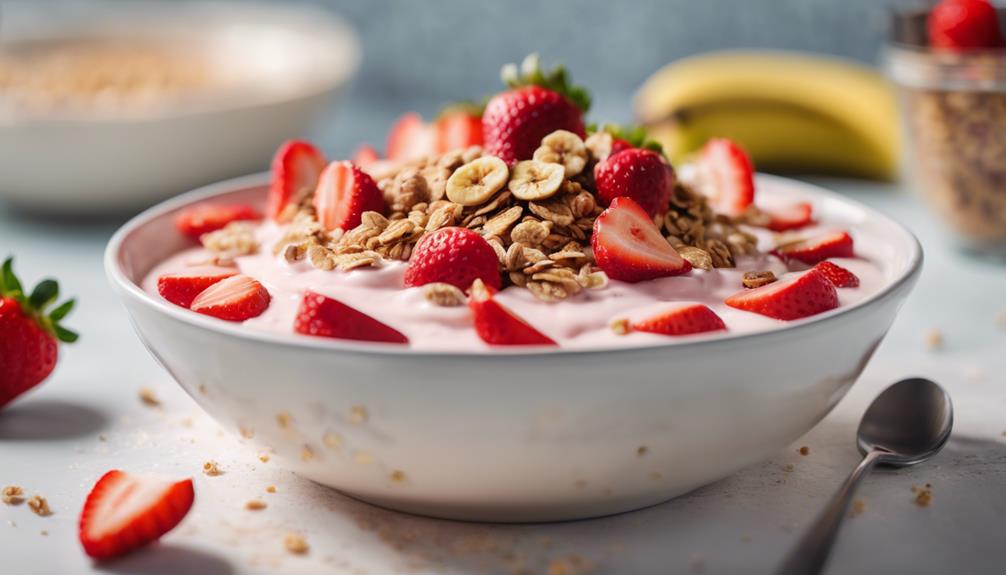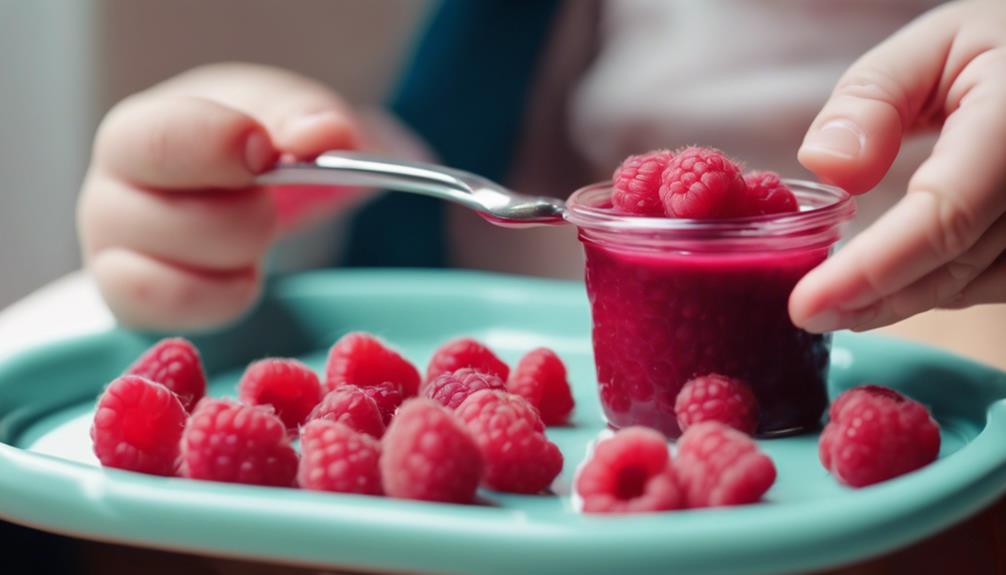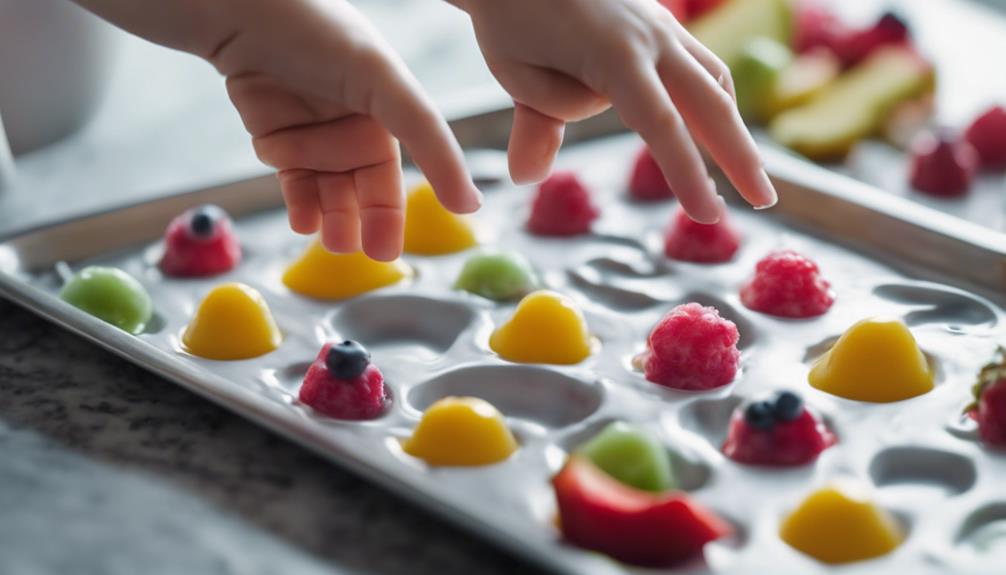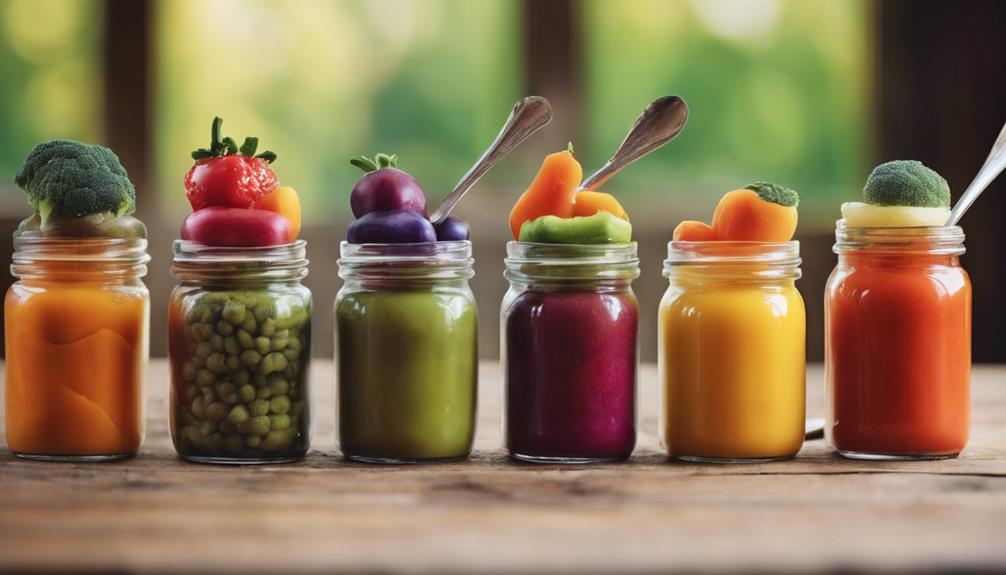Craft a nutritious peach puree by using fresh, firm, and ripe peaches. Keep skin on for added nutrients and fiber. Consider white or yellow peaches for a smoother texture. Cook by steaming, boiling, or baking to enhance flavors without adding sweeteners. These peaches are rich in vitamins A and C, aiding bone health and digestion. Use a blender or food processor for a smooth consistency. This recipe, created by Brittany of Eating Bird Food, provides essential nutrients for your little one. For more details on this delectable peach puree, explore the full recipe to guarantee a wholesome meal for your baby.
Key Takeaways
- Use fresh, firm, ripe peaches for optimal flavor and nutrients.
- Retain peach skin or opt for blanched peaches for different textures.
- Experiment with cooking methods and ingredients to enhance flavor.
- Ensure equipment like a blender or food processor for smooth puree.
- Store peach puree in small containers or ice cube trays for convenience.
Peach Puree Preparation Methods
To prepare peach puree, you have the choice of using fresh peaches with the skin on or blanched peaches with the skin removed. For a quick puree, simply wash and pit fresh peaches before blending them in a high-powered blender. This method retains the skin's nutrients and fiber, perfect for a baby's developing palate.
On the other hand, if you prefer a smoother texture, opt for blanched peaches. To do this, immerse the peaches in boiling water for a minute, then transfer them to an ice bath to easily peel off the skin. Once peeled, blend the peaches until smooth in your trusty blender.
When selecting peaches for pureeing, choose firm and ripe ones without any bruises. Remember, for baby food, it's best to avoid adding sweeteners like honey or maple syrup. With either method, your little one will enjoy the sweet and natural flavors of fresh peach puree.
Choosing and Using Peaches
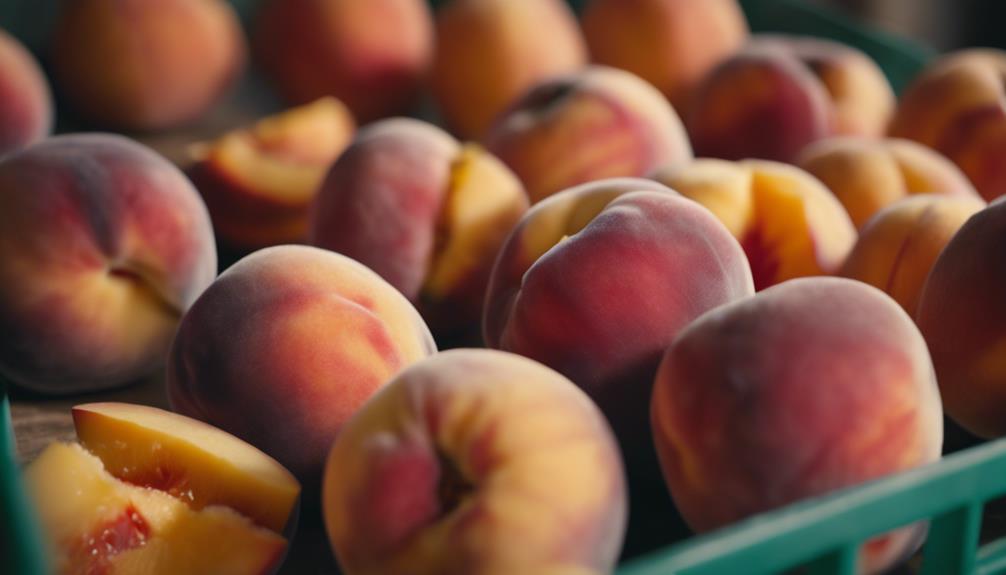
When selecting peaches for baby food, opt for fresh, firm ones without any bruising.
Both white and yellow peaches can be used, with white peaches offering a sweeter taste.
Peach Selection Tips
Choose fresh, firm peaches without bruising to guarantee optimal puree for your peach baby food recipe. When selecting peaches, opt for ones that are free from soft spots or blemishes, as these may affect the taste and texture of your puree.
Both white and yellow peaches work well for baby food, with white peaches offering a sweeter flavor profile. Look for ripe peaches that yield slightly to pressure when gently squeezed, as these will provide the best taste for your little one.
While you can adjust the sweetness of desserts with honey or maple syrup, it's best to avoid adding these sweeteners to baby food. Peaches are versatile and can be combined with various ingredients to create nutritious and delicious meals for your baby.
Peaches for Babies
Choose fresh, firm peaches without bruising to guarantee top-quality peach puree for your baby's meals. When using fresh peaches to make homemade baby food, look for ripe ones that slightly yield to pressure. Both white and yellow peaches work well for peach puree, with white peaches offering a sweeter flavor profile.
Here are some tips for using fresh peaches for your little one's first food:
- Selecting the Perfect Peach: Opt for peaches that are fragrant and free of blemishes or soft spots. This secures a flavorful and nutritious base for your baby's meals.
- Preparing the Peaches: Wash the peaches thoroughly, peel them, remove the pit, and chop them into small pieces before cooking. This process helps in creating a smooth and digestible texture for your baby.
- Cooking Techniques: You can cook peaches for your baby by steaming, boiling, or baking them until they're soft and easy to mash. Avoid adding sweeteners like honey or maple syrup when making peach puree for your baby, as their delicate palates are best introduced to the natural sweetness of fresh fruits.
Flavor Enhancements
To enhance the flavor of your peach puree for your baby, consider experimenting with different cooking methods and complementary ingredients.
When making homemade peach baby food, opt for fresh, firm peaches without bruising to ensure the best taste and texture. Both white and yellow peaches are suitable for purees, with white peaches offering a sweeter flavor profile. For ideal taste, choose ripe peaches that yield slightly to pressure.
To achieve a smoother consistency ideal for baby food, peel and chop the peaches before pureeing them.
While you can adjust the sweetness of peach puree for desserts by adding honey or maple syrup, it's recommended to avoid sweeteners when preparing baby food.
Peach Puree for Babies
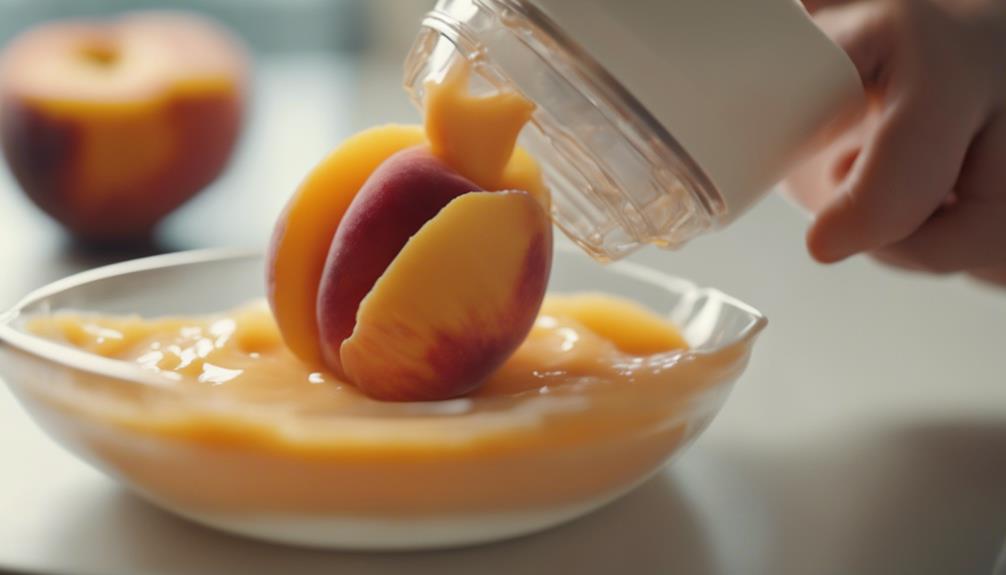
When introducing peach puree to your baby, you're providing a nutrient-rich option that's loaded with essential vitamins and fiber.
This flavorful baby food not only offers a sweet taste but also contributes to your little one's growth and development.
Nutrient-Rich Peach Puree
For nutrient-rich peach puree that's ideal for babies, consider blending ripe peaches into a smooth and flavorful concoction. This homemade baby food is packed with essential nutrients important for your infant's growth and development.
Here's why incorporating peach puree into your baby's diet is a fantastic idea:
- Vitamins Galore: Peaches are rich in vitamins A and C, providing a natural boost to your baby's immune system and overall health.
- Bone Health Support: The calcium content in peach puree aids in bone growth, ensuring your little one develops strong and healthy bones.
- Digestive Aid: The fiber in peaches promotes healthy digestion in infants, preventing common tummy troubles and promoting a happy baby.
Including nutrient-rich peach puree in your baby's meals not only offers a fresh and flavorful option but also ensures they receive the necessary nutrients for best growth and development.
Flavorful Baby Food
Consider blending ripe peaches into a smooth puree to introduce your baby to a diverse range of flavors and essential nutrients. Peaches, a nutritious fruit rich in vitamins A and C, calcium, and fiber, offer numerous health benefits for your little one. By incorporating peaches into homemade baby food purees, you can support your baby's brain development, bone growth, digestion, and eyesight.
Additionally, peaches provide a sweet and appealing taste that babies enjoy, making them a popular choice for flavorful baby food recipes.
Creating peach puree at home is a simple process that allows you to control the ingredients and ensure a nutrient-rich meal for your baby. The versatility of peach puree enables you to mix it with other fruits and vegetables, enhancing the variety of flavors in your baby's diet. Introducing different tastes early on can help expand your baby's palate and encourage a lifelong appreciation for diverse foods.
Thawing Frozen Peach Puree

To thaw frozen peach puree, place it in the fridge overnight for gradual defrosting. This method helps preserve the flavor and texture of the puree.
If you're seeking a quicker thaw, a warm water bath is a safe alternative. Here's a simple guide to help you defrost frozen peach puree effectively:
- Fridge Method: Place the frozen peach puree in the refrigerator the night before you plan to use it. This slow defrosting process preserves the taste and nutrients of the puree.
- Warm Water Bath: If you need the peach puree ready sooner, submerge the sealed container in a bowl of warm water. Make sure the water doesn't seep into the container to maintain the consistency of the puree.
- Small Portions: Freezing peach puree in small portions, such as using silicone ice cube trays or freezer-safe jars, allows for easy defrosting of only the amount you need, keeping the rest fresh for later use.
Nutritional Information and Equipment
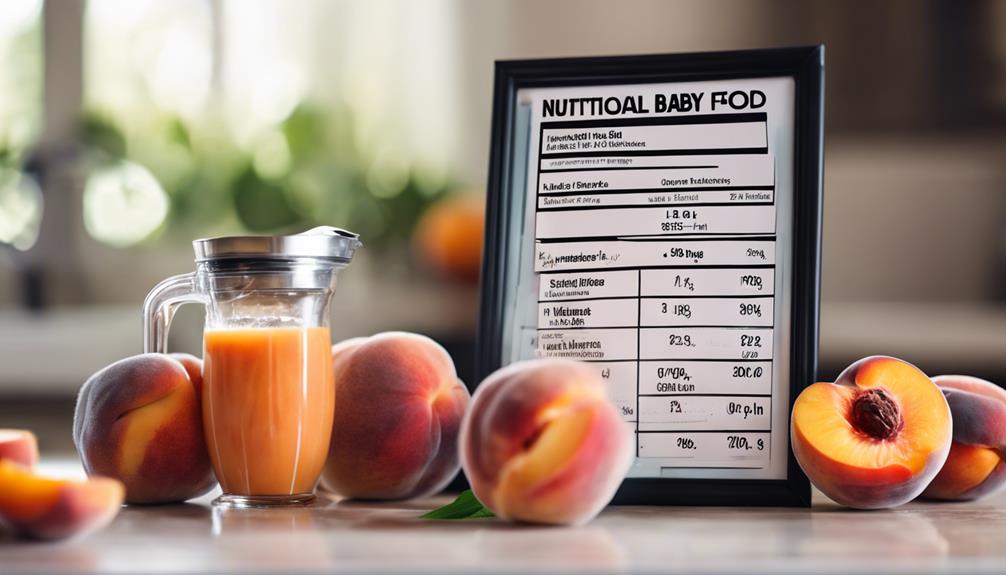
When considering the nutritional aspect of the peach puree recipe, it's important to note the calorie count, carbohydrate content, protein amount, and potassium levels per serving.
Additionally, having a blender and food processor on hand is necessary equipment for preparing this dish.
Understanding the course classification and the talented creator behind the recipe can provide context and insight into the overall composition and purpose of this peach baby food.
Nutritional Content Summary
You can find essential details about the nutritional content and required equipment for making peach baby food in this section.
When preparing peach puree for your little one, bear in mind the following nutritional content summary:
- A 1/2 cup serving of peach puree contains approximately 38kcal, providing a low-calorie option for your baby's diet.
- With 9g of carbohydrates per serving, peach puree offers a natural source of energy for your little one's activities.
- Peach puree also contains 1g of protein and 186mg of potassium per serving, contributing to your baby's growth and overall health.
To create this nutritious baby food, make sure you have a blender or food processor on hand. These tools are essential for achieving a smooth and creamy texture in your peach puree.
With peach puree being a staple in American cuisine and commonly used in baby food recipes, you can rest assured that this homemade treat is both delicious and wholesome for your little one.
Required Equipment Details
For making the peach baby food recipe discussed earlier, make sure you have a blender or food processor ready as the required equipment. Both a blender and a food processor are suitable for creating the smooth peach puree needed for this recipe. These appliances will help you achieve the desired consistency, making the peach puree easy for your little one to consume. Below is a table highlighting the significance of having either a blender or food processor for this recipe:
| Equipment | Significance |
|---|---|
| Blender | Ideal for creating smooth purees |
| Food Processor | Great for processing fruits |
Having the necessary equipment, such as a blender or food processor, is vital for successfully preparing the peach puree. These tools will aid in breaking down the peaches and blending them into a silky texture suitable for your baby's consumption. Ensure that your chosen blender or food processor is in good working condition before starting the recipe to guarantee a smooth cooking experience.
Recipe Course and Creator
The Peach Baby Food Recipe, crafted by Brittany of Eating Bird Food, provides a nourishing mix of 38kcal, 9g carbs, 1g protein, and 186mg potassium per 1/2 cup serving. Here's a breakdown of the recipe course and creator:
- Course Categories:
The Peach Baby Food Recipe falls under the course categories of Baby Food and Sauces/Condiments, highlighting its suitability for infants and as a taste enhancer for various dishes.
- Creator:
Brittany, a cookbook author and health coach, is the brains behind this American-inspired peach baby food. Her expertise guarantees a delicious and nourishing blend that your little one will enjoy.
- Equipment Needed:
To make this peach baby food, you'll need a blender and food processor. These tools are crucial for achieving a smooth and consistent puree that's ideal for your baby's consumption.
Brittany's recipe demonstrates the adaptability of peaches in baby food, providing a delightful choice for introducing new flavors to your little one's diet.
Recipe Details

Consider incorporating a food mill, food processor, or blender for smooth pureeing of the organic peaches in the peach baby food recipe. These tools can help achieve a velvety consistency, ideal for your little one's delicate palate.
The recipe calls for organic peaches and 100% baby apple juice, ensuring a natural and sweet flavor without any additives.
To streamline the process, using frozen peaches that have been defrosted can save time and offer flexibility in preparation.
Once the peaches are peeled, chopped, cooked, and pureed, storing the peach puree in 2 oz. containers or ice cube trays allows for convenient portioning and serving.
Baby Food Preparation

Start by washing, peeling, and pitting the peaches as the initial steps in preparing homemade peach baby food. Once the peaches are ready, you can move on to the next steps in making peach baby food:
- Steaming or Blending: Depending on your baby's age and preferences, you may need to steam the peaches to soften them or blend them into a smooth puree. Steaming helps retain nutrients, while blending guarantees a texture suitable for your baby.
- Serving Homemade Peach Baby Food: After preparing the homemade peach puree, make sure it has cooled down to an appropriate temperature before serving it to your little one. Serving homemade peach baby food assures that your baby is getting a nutritious and preservative-free meal.
- Making Peach Baby Food: The process of making peach baby food is simple yet rewarding. By following these steps, you can provide your baby with a delicious and healthy treat crafted with love.
Community Engagement

Engage with the community by sharing your experiences and tips in the comment section below. Readers actively participate in recipe-related discussions, showcasing a shared interest in making fresh baby food.
The comment section serves as a platform for community engagement, where participants interact by discussing variations, substitutions, and their babies' reactions to the peach baby food recipe. This interaction fosters a sense of camaraderie among readers, particularly those excited about their babies starting solids.
The author encourages feedback and ratings to further enhance community engagement. Through these exchanges, a supportive environment is created where individuals can seek advice, share their successes, and troubleshoot any challenges they may face while preparing this sweet and juicy puree for their little ones.
Join the conversation, contribute your insights, and be part of this vibrant community centered around creating nutritious and delicious meals for your baby.
Feedback and Suggestions

Share your thoughts and suggestions on enhancing the flavor and texture of peach baby food by commenting below.
When considering ways to improve your homemade baby food, here are some ideas to inspire your culinary creativity:
- Experiment with Flavor Combinations: Try adding a hint of cinnamon or a splash of vanilla extract to enhance the taste of your peach puree.
- Enhance Tartness: If you prefer a tangier flavor, consider including a squeeze of fresh lemon juice or a sprinkle of citrus zest into your peach puree.
- Explore Spices: Don't hesitate to explore different spices like ginger or nutmeg to add a subtle warmth to your baby's meal.
As you commence on this exciting journey of starting solids with your little one, remember that the beauty of fresh baby food lies in the ability to customize it to suit your baby's preferences.
The shared interest in making homemade baby food among parents fosters a supportive community where tips, experiences, and flavor suggestions are freely exchanged.
Contest Participation and Social Media
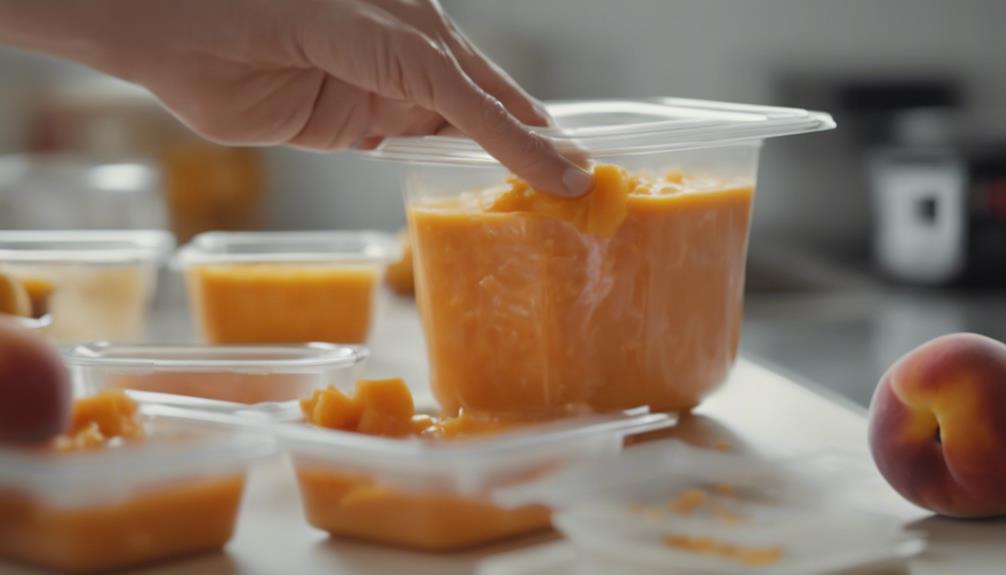
Explore the array of recipes, updates, and interactive opportunities available on social media accounts to enhance your experience with the peach baby food contest.
The contest saw a surge in entries, with enthusiastic participants showcasing their interest. Your engagement through comments has played a crucial role in encouraging active participation from readers.
The comment section serves as a platform for recipe feedback and community interaction, fostering a sense of camaraderie among participants. Readers were prompted to share their experiences, rate the recipe, and provide valuable feedback, contributing to a dynamic exchange of ideas.
Social media has proven to be an essential tool for extending the reach of the contest, attracting a diverse audience and facilitating meaningful interactions. By leveraging social media channels, you can't only stay updated on contest developments but also actively engage with a vibrant community of parents and caregivers invested in creating nutritious and delicious meals for their little ones.
Frequently Asked Questions
Is Peach Puree Good for Babies?
Peach puree is excellent for babies! It's packed with essential vitamins, aids digestion, and supports growth. The natural sweetness appeals to little ones and introduces them to new flavors. Including peach puree is a nutritious choice for your baby's well-being.
How to Prepare Peach for a 7 Month Old?
To prepare peaches for a 7-month-old, peel, pit, and chop ripe peaches into small pieces to prevent choking. Cook them until soft, then mash or puree. Avoid adding sweeteners. Start with small amounts and watch for allergies. Gradually increase servings as they enjoy.
What Goes With Peaches Baby Food?
Pair peaches with apples, pears, carrots, sweet potatoes, or yogurt for your baby's meals. Mixing peaches with various foods introduces new flavors and nutrients. Try different combos to broaden your baby's palate!
What Is the Best Puree to Give a Baby First?
For your little one's first puree, start with a single-ingredient fruit like peach. Its mild flavor, rich nutrients, natural sweetness, and easy digestion make it a popular choice. Prepare fresh at home for quality control.
Conclusion
To sum up, peach puree is a sweet and nutritious option for your little one.
Did you know that peaches are a great source of vitamins A and C, as well as fiber?
By incorporating this delicious fruit into your baby's diet, you're providing essential nutrients for their growth and development.
So why not try making some peach puree today and watch your baby enjoy every bite!
